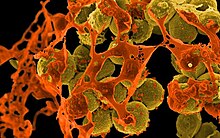Staphylococcal infection


A staphylococcal infection (also called staph infection) is an infection caused by a Staphylococcus bacterium. Staphylococcus can cause many different infections. It can also cause food poisoning.
Staphylococcus aureus
[change | change source]Staphylococcus aureus is a staphylococcus bacterium that can cause dangerous or even fatal diseases. Because Staphylococcus aureus can live on dry surfaces, such as doorknobs or tables, for longer than most bacteria, someone can get sick from Staphylococcus aureus from touching one of those surfaces if someone with a staphylococcal infection has touched it even if there is nobody who has a staphylococcal infection near them. Staphylococcus aureus can also cause toxic shock syndrome by releasing toxins into the bloodstream.
Methicillin-resistant Staphylococcus aureus
[change | change source]Methicillin-resistant Staphylococcus aureus is Staphylococcus aureus that is not cured by the antibiotic Methicillin or any other penicillin or cephalosporin antibiotics. This is called antibiotic resistance. Because penicillin and cephalosporin are the most important drugs that doctors use to treat Staphylococcus aureus infections, doctors may not be able to cure people with MRSA.
Types of staph infections
[change | change source]| Type | Description | Example |
|---|---|---|
| Localised skin infections | Small infections that usually aren't serious | Abscesses, boils, and carbuncles |
| Diffuse skin infections | Contagious skin infections that can be serious | Impetigo |
| Deep localised infections | Infections that are often very painful but do not spread to the blood | Septicemia and necrotising pneumonia |
| Toxinoses | Toxins in the bloodstream | Gastroenteritis and toxic shock syndrome |
Other Staphylococcus bacteria
[change | change source]Other Staphylococcus bacteria can cause infections, including Staphylococcus epidermidis and Staphylococcus saprophyticus. Staphylococcus epidermidis is a bacterium that is normally on the skin. If someone has a disease that makes his or her immune system work badly, this bacterium might give him or her an infection. Staphylococcus saprophyticus can cause urinary tract infections in women.
